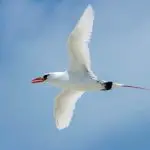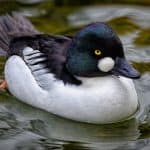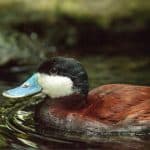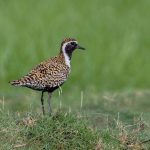Common Name: Belted Kingfisher
Scientific Name: (Megaceryle alcyon)| Size | Diet | Range in Hawaii | Status in Hawaii |
|---|---|---|---|
| 11 in. - 14 in. | fish, small crustaceans, amphibians and insects | Big Island, Kaua'i, O'ahu, Moloka'i, and Maui | Least Concern |
The Belted Kingfisher (Megaceryle alcyon) is a fascinating and unique bird species that is known for its distinctive blue and white plumage and its remarkable fishing abilities. With its powerful beak and keen eyesight, this kingfisher is a formidable hunter in its natural habitat.
Although it is not a native species to Hawaii, Belted Kingfishers have been spotted occasionally on the islands as non-breeding visitors or vagrants, making for a rare and exciting sighting for birdwatchers. In this article, we’ll explore the fascinating world of the Belted Kingfisher and learn more about its unexpected presence in Hawaii.
Belted Kingfisher
Appearance
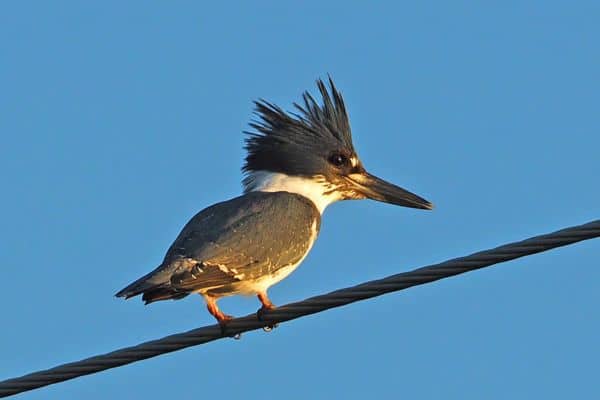
The Belted Kingfisher is a distinctive bird with a unique appearance. It has a stocky build, large head, and a long, sturdy bill. The upper parts of its body, including the head, wings, and back, are predominantly blue-gray in color.
The underparts are white, and the neck and breast display a prominent blue-gray band, often referred to as a “belt.” The female Belted Kingfisher has an additional reddish-brown band across the lower breast, while the male has a single blue-gray band.
In terms of size, Belted Kingfishers are considered medium-sized birds. On average, they measure about 11-14 inches (28-36 centimeters) in length from the tip of their bill to the end of their tail.
They have a wingspan of approximately 19-23 inches (48-58 centimeters). The Belted Kingfisher’s striking appearance and robust build make it easily recognizable among other bird species.
Diet
The Belted Kingfisher is a skilled and specialized hunter, primarily feeding on fish. As its name suggests, its diet consists predominantly of small fish, which it catches by diving into bodies of water from perches such as branches or posts.
With its keen eyesight, the Belted Kingfisher can spot fish swimming near the water’s surface. Once it spots its prey, it plunges into the water with a characteristic head-first dive, using its strong bill to capture the fish.
While fish make up the majority of its diet, Belted Kingfishers are opportunistic hunters and may also feed on other aquatic creatures. They may consume small crustaceans, amphibians, insects, and even small mammals or reptiles when fish are less available. After catching its prey, the Belted Kingfisher returns to a perch, where it may beat the fish against the perch to subdue it before swallowing it whole.
Nesting
The Belted Kingfisher constructs its nests in burrows, typically dug into earthen banks near bodies of water such as rivers, streams, lakes, or coastal areas. Both males and females participate in excavating the burrow, using their bills and feet to dig into the soil or loose sediment. The burrow can range from a few feet to several meters in length, often sloping upward to prevent flooding.
The nesting chamber at the end of the burrow is usually unlined, although some nesting pairs may create a small nesting bed using regurgitated fish bones or other materials. The entrance of the burrow is typically narrow and just wide enough to allow the birds to enter and exit.
Belted Kingfishers are known for their solitary nesting habits, with each pair claiming their own territory. They are highly territorial and defend their nesting sites vigorously against intruders, including other kingfishers.
Within the nesting chamber, the female Belted Kingfisher lays a clutch of 5 to 8 eggs, which she incubates for about 23 to 24 days. Once the eggs hatch, both parents share the responsibilities of feeding the chicks and maintaining the nest. The chicks grow rapidly and are able to leave the nest and fly after about 27 to 29 days.
Behavior
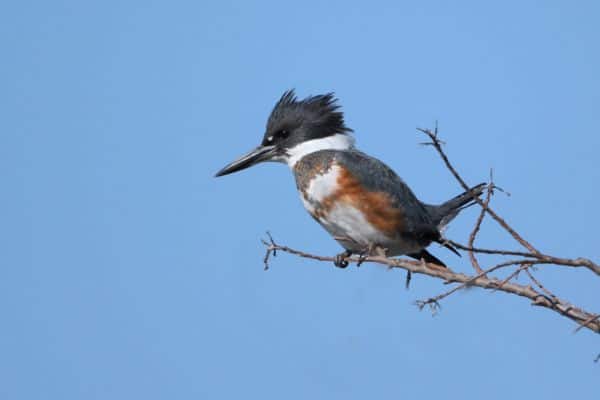
The Belted Kingfisher exhibits fascinating behaviors that are well adapted to its life near water. One of its most distinctive behaviors is fishing. Perched on branches or posts near the water’s edge, the Belted Kingfisher scans the surface for fish.
With remarkable precision, it dives headfirst into the water, using its sharp beak to capture its prey. Plunging from heights of up to 25 feet (7.6 meters), it can catch fish larger than its own size.
Territoriality is another prominent behavior of the Belted Kingfisher. It fiercely defends its feeding and nesting territories against intruders, including other kingfishers. Its loud calls and aerial displays serve as warning signals and territorial markers.
Vocalizations play a crucial role in communication, territorial defense, and courtship displays. The male’s high-pitched, rattling call is longer than that of the female.
Perching and observation are common behaviors of Belted Kingfishers. They spend significant time perched on branches or other elevated positions near water, bobbing their heads and flicking their tails. From these vantage points, they maintain a vigilant watch over their surroundings, ready to dive at the sight of potential prey.
The Belted Kingfisher’s excavation skills are impressive. Both males and females actively participate in digging burrows in earthen banks near water.
Using their bills and feet, they create tunnels that lead to nesting chambers. These burrows provide safe and secure places for breeding and rearing their young.
In addition, Belted Kingfishers exhibit migratory behavior in many regions. They breed in northern areas and migrate southward to more temperate or warmer regions during the winter months. Some individuals undertake long-distance migrations, spanning from North America to the West Indies or South America.
Habitat
The Belted Kingfisher is primarily found in habitats associated with water sources. It prefers a diverse range of environments, including freshwater habitats such as rivers, streams, lakes, ponds, and marshes, as well as coastal areas and estuaries. These habitats provide the necessary resources for the kingfisher’s hunting and nesting behaviors.
The kingfisher’s habitat typically includes a combination of water, trees or perching structures, and nearby open spaces. It requires clear or slightly turbid water with suitable fish populations to support its feeding habits. The presence of steep banks, cliffs, or overhanging branches along the water’s edge is important for the kingfisher to perch and observe its surroundings before diving for prey.
Vegetation is an integral part of the Belted Kingfisher’s habitat. It relies on trees and shrubs along the waterways for nesting and roosting sites. These may include mature trees with suitable cavities or burrow-friendly banks where the kingfishers excavate their nesting burrows.
The kingfisher’s habitat often includes a mix of open areas and vegetation, allowing it to spot fish and other prey from its perches. It may also utilize adjacent fields, meadows, or grasslands for hunting, where it can hover briefly before diving into the water. Coastal habitats such as mangroves, salt marshes, and tidal flats are also utilized by the Belted Kingfisher, especially during migration or in coastal regions.
Range
The Belted Kingfisher is a species that is primarily found in North America, including Canada and the United States. However, during the winter months, some Belted Kingfishers migrate southward to warmer regions, including the Hawaiian Islands.
While their presence in Hawaii is considered relatively uncommon, there have been sightings and reports of Belted Kingfishers on multiple islands in the state, including Big Island, Kaua’i, O’ahu, Moloka’i, and Maui. These sightings suggest that a small number of Belted Kingfishers venture to Hawaii during their winter migration, possibly seeking suitable foraging opportunities and favorable habitat conditions.
Conservation Status
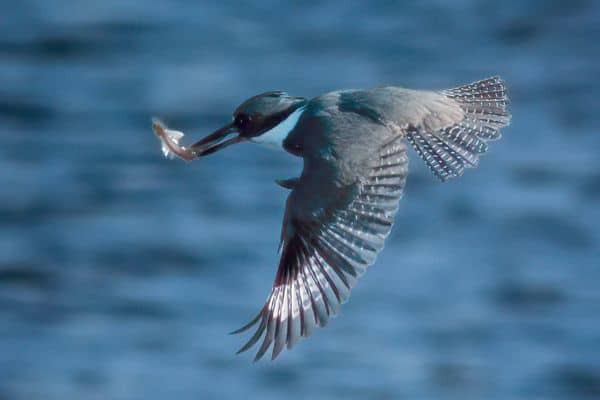
The Belted Kingfisher is listed as a species of least concern according to the International Union for Conservation of Nature (IUCN). This status indicates that the species has a stable population and does not currently face any major threats or significant decline in numbers.
Interesting Facts
1. Impressive diving abilities
This bird is an expert fisher and is known for its exceptional diving skills. It can hover above the water and then plunge headfirst to catch its prey, using its strong bill to snatch fish, crayfish, and other aquatic creatures.
2. Reverse sexual dimorphism
In the case of Belted Kingfishers, the females are actually more brightly colored than the males. The rusty-colored band on the female’s belly sets them apart from the males, who lack this feature.
3. Excellent vision
These birds have excellent vision, allowing them to spot their prey from considerable distances. They can accurately judge the position of fish beneath the water’s surface and make precise dives to catch them.
4. Territorial nature
Belted Kingfishers are highly territorial and fiercely defend their nesting sites and fishing grounds. They often engage in aerial displays and aggressive behaviors to protect their territory from intruders.
Frequently Asked Questions
1. How do Belted Kingfishers communicate?
Belted Kingfishers are known for their distinctive calls. They produce a rattling, harsh call that sounds like a rapid series of notes. These calls are used for communication, territory defense, and mate attraction.
2. How long do Belted Kingfishers live?
Belted Kingfishers have an average lifespan of around 6 to 7 years in the wild. However, some individuals have been known to live up to 10 years or more.
3. Are Belted Kingfishers solitary birds?
While Belted Kingfishers are generally solitary during non-breeding periods, they do establish territories and defend them vigorously. However, during the breeding season, male and female kingfishers form pairs and work together in raising their young.
4. Do Belted Kingfishers migrate long distances?
Belted Kingfishers are known to migrate over moderate distances, particularly in regions with colder climates. However, the migration patterns can vary depending on the population and location. Some populations may undertake shorter local movements instead of long-distance migrations.

